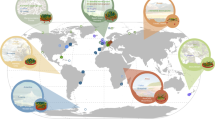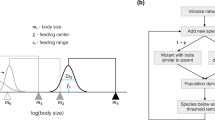Abstract
Food webs are descriptions of who eats whom in an ecosystem. Although extremely complex and variable, their structure possesses basic regularities1,2,3,4,5,6. A fascinating question is to find a simple model capturing the underlying processes behind these repeatable patterns. Until now, two models have been devised for the description of trophic interactions within a natural community7,8. Both are essentially based on the concept of ecological niche, with the consumers organized along a single niche dimension; for example, prey size8,9. Unfortunately, they fail to describe adequately recent and high-quality data. Here, we propose a new model built on the hypothesis that any species' diet is the consequence of phylogenetic constraints and adaptation. Simple rules incorporating both concepts yield food webs whose structure is very close to real data. Consumers are organized in groups forming a nested hierarchy, which better reflects the complexity and multidimensionality of most natural systems.
This is a preview of subscription content, access via your institution
Access options
Subscribe to this journal
Receive 51 print issues and online access
$199.00 per year
only $3.90 per issue
Buy this article
- Purchase on Springer Link
- Instant access to full article PDF
Prices may be subject to local taxes which are calculated during checkout



Similar content being viewed by others
References
Cohen, J. E. Food Webs and Niche Space (Princeton Univ. Press, Princeton, New Jersey, 1978)
Sugihara, G. Niche Hierarchy: Structure Assembly and Organization in Natural Communities. PhD Thesis, Princeton Univ., Princeton (1982)
Cohen, J. E., Briand, F. & Newman, C. N. Community Food Webs: Data and Theory (Springer, Berlin, 1990)
Havens, K. E. Scale and Structure in Natural Food Webs. Science 257, 1107–1109 (1992)
Bersier, L. F. & Sugihara, G. Scaling regions for food web properties. Proc. Natl Acad. Sci. USA 94, 1247–1251 (1997)
Solow, A. R. & Beet, A. R. On lumping species in food webs. Ecology 79, 2013–2018 (1998)
Cohen, J. E. & Newman, C. M. A stochastic theory of community food webs I. Models and aggregated data. Proc. R. Soc. Lond. B 224, 449–461 (1985)
Williams, R. J. & Martinez, N. D. Simple rules yield complex food webs. Nature 404, 180–183 (2000)
Lawton, J. H. & Warren, P. H. Static and dynamic explanations for patterns in food webs. Trends Ecol. Evol. 3, 242–245 (1988)
DeAngelis, D. L. Stability and connectance in food web models. Ecology 56, 238–243 (1975)
Kondoh, M. Foraging adaptation and the relationship between food-web complexity and stability. Science 299, 1388–1391 (2003)
Gardner, M. & Ashby, W. Connectance of large dynamic (cybernetic) systems: critical values for stability. Nature 228, 784 (1970)
May, R. M. Stability and Complexity of Model Ecosystems (Princeton Univ. Press, Princeton, New Jersey, 1974)
Pimm, S. L. Food Webs (Chapman and Hall, London, 1982)
Cousins, S. H. The trophic continuum in marine ecosystems: Structure and equations for a predictive model. Can. J. Fish. Aquat. Sci. 213, 76–93 (1985)
Legendre, P. & Legendre, L. Numerical Ecology (Elsevier, Amsterdam, 1998)
Diamond, J. M. in Ecology and Evolution of Communities (eds Cody, M. L. & Diamond, J. M.) 342–444 (Belknap/Harvard Univ. Press, Cambridge, Massachusetts, 1975)
Price, P. W. Macroevolutionary Theory on Macroecological Patterns (Cambridge Univ. Press, Cambridge, 2003)
Martinez, N. D. Constant connectance in community food webs. Am. Nat. 139, 1208–1218 (1992)
Cohen, J. E., Jonsson, T. & Carpenter, S. R. Ecological community description using the food web, species abundance, and body size. Proc. Natl Acad. Sci. USA 100, 1781–1786 (2003)
Sugihara, G. in Population Biology. Proceedings of Symposia in Applied Mathematics (ed. Levin, S. A.) 83–101 (American Mathematical Society, Providence, Rhode Island, 1984)
Sugihara, G., Bersier, L. F., Southwood, T. R. E., Pimm, S. L. & May, R. M. Predicted correspondence between species abundances and dendrograms of niche similarities. Proc. Natl Acad. Sci. USA 100, 5246–5251 (2003)
Warren, P. H. Spatial and temporal variation in the structure of a freshwater food web. Oikos 55, 299–311 (1989)
Baird, D. & Ulanowicz, R. E. The seasonal dynamics of the Chesapeake bay ecosystem. Ecol. Monogr. 59, 329–364 (1989)
Hall, S. J. & Raffaelli, D. Food-web patterns: lessons from a species-rich web. J. Anim. Ecol. 60, 823–842 (1991)
Polis, G. A. Complex trophic interactions in deserts: an empirical critique of food-web theory. Am. Nat. 138, 123–155 (1991)
Goldwasser, L. & Roughgarden, J. Construction and analysis of a large Caribbean food web. Ecology 74, 1216–1233 (1993)
Martinez, N. D. Artifacts or attributes? Effects of resolution on the Little Rock Lake food web. Ecol. Monogr. 61, 367–392 (1991)
Jaccard, P. Nouvelles recherches sur la distribution florale. Bull. Soc. Vaudoise Sci. Nat. 44, 223–270 (1908)
Acknowledgements
We thank J. Bascompte, S. Cousins, S. Hubbell, R. Naisbit and P. Warren for useful comments. This work was funded by the Swiss National Science Foundation, the Novartis Foundation, and partly by the National Center of Competence in Research ‘Plant Survival’.
Author information
Authors and Affiliations
Corresponding author
Ethics declarations
Competing interests
The authors declare that they have no competing financial interests.
Rights and permissions
About this article
Cite this article
Cattin, MF., Bersier, LF., Banašek-Richter, C. et al. Phylogenetic constraints and adaptation explain food-web structure. Nature 427, 835–839 (2004). https://doi.org/10.1038/nature02327
Received:
Accepted:
Issue Date:
DOI: https://doi.org/10.1038/nature02327
This article is cited by
-
Impacts of Aggregation Methods and Trophospecies Number on the Structure and Function of Marine Food Webs
Journal of Ocean University of China (2024)
-
The role of intra-guild indirect interactions in assembling plant-pollinator networks
Nature Communications (2023)
-
Colonization–competition dynamics of basal species shape food web complexity in island metacommunities
Marine Life Science & Technology (2023)
-
Effect of altitude and spatial heterogeneity on the host-parasite relationship in anurans from a remnant humid forest in the brazilian semiarid
Parasitology Research (2023)
-
Energy of interval-valued fuzzy graphs and its application in ecological systems
Journal of Applied Mathematics and Computing (2022)
Comments
By submitting a comment you agree to abide by our Terms and Community Guidelines. If you find something abusive or that does not comply with our terms or guidelines please flag it as inappropriate.



